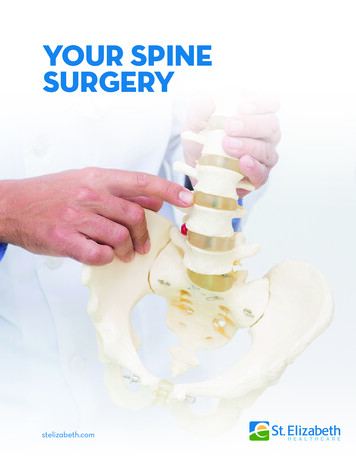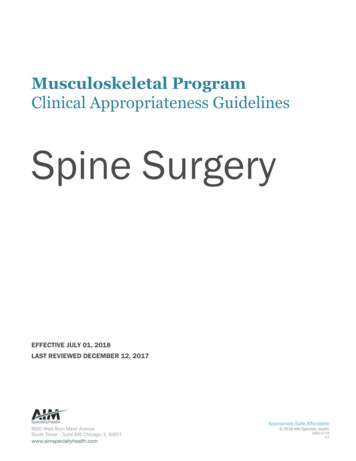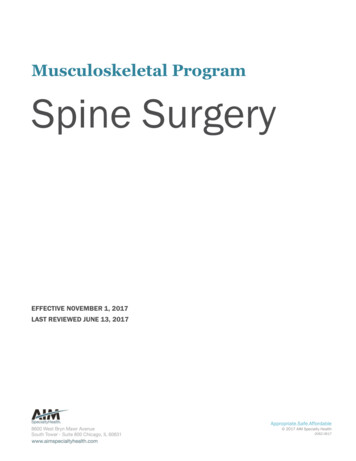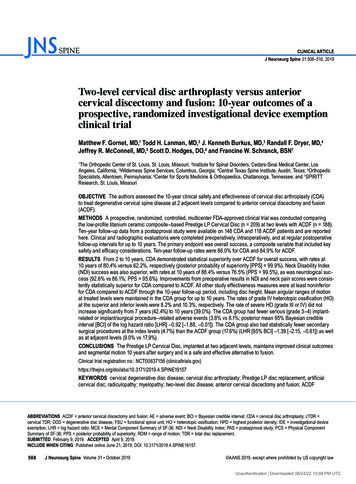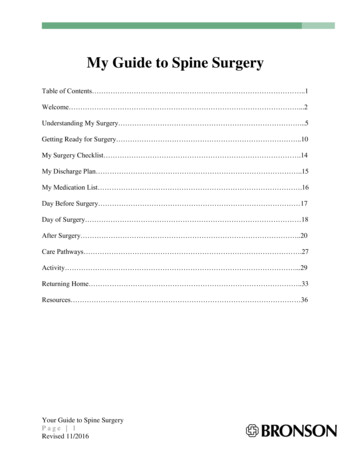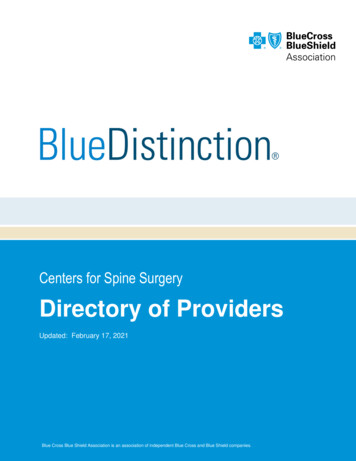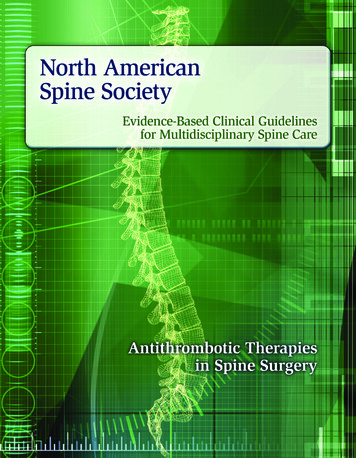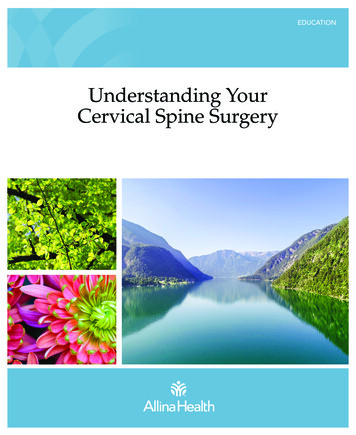
Transcription
EDUCATIONUnderstanding YourCervical Spine Surgery
Your nameSurgery dateYour follow-up appointment with your surgeon is:DateSurgeonPlease bring this book to:all appointmentsyour pre-surgery education classthe hospital on the day of surgery.TimePhone number
Understanding Your Cervical Spine SurgeryFirst editionDeveloped by Allina Health 2019 Allina Health SystemThe publisher believes that information in this manual was accurate at the timethe manual was published. However, because of the rapidly changing state of scientificand medical knowledge, some of the facts and recommendations in the manual may beout-of-date by the time you read it. Your health care provider is the best sourcefor current information and medical advice in your particular situation.All rights reserved. No part of this book may be reproduced in any form or by any means, electronicor mechanical, including photocopying, without permission in writing from the publisher.DisclaimerThis publication is for general information only and is not intended to provide specific advice or recommendations for anyindividual. The information it contains cannot be used to diagnose medical conditions or prescribe treatment. The informationprovided is designed to support, not replace, the relationship that exists between a patient and his/her existing physician.For specific information about your health condition, please contact your health care provider.
Before Your SurgeryChecklist Contact your surgeon’s office if you are planning to visitthe dentist within 1 month before your surgery. Schedule your health history and physical exam.You can read more about this on page 9. Make sure to talk with your health care provider about all ofthe medicines you take and if you need to stop taking thembefore surgery. Use the chart on page 13 to do this. Schedule your pre-surgery education class or watch thepre-surgery video if your hospital does not offer the class.You can read more about this on page 10. Review your leaving the hospital (discharge) criteria.You can read more about this on page 37. Review and complete any paperwork you received. Fill out the insurance coverage worksheet on page 11.Call your insurance provider if you have questions.Did You Know?Your care circle is yourfamily, friends and othersclose to you. This term willbe used throughout thisbook. Contact your surgeon’s office if you have any health changes(sore throat, cold, fever, dental problem, urinating problem)or skin changes (rash, cuts). Select a member of your care circle (family, friends and othersclose to you) to be your personal support coach. This personwill provide support and encourage you to meet milestonesduring your recovery. Talk with your care circle about your needs after surgery.Members of Your Care CircleName: Phone:Name: Phone:Name: Phone:Name: Phone:Name: Phone:2
Table of ContentsIntroductionWelcome 5Understanding Your Back 6Chapter 1: Before SurgeryYour Health History and Physical Exam 9Diabetes 9Pre-surgery Education Class 10Hospital Pre-registration 10Determining Your Health Insurance Coverage 11Medicine Use Before Surgery 12Advance Care Planning 13Quit Tobacco for Your Surgery 14Chapter 2: Preparing for SurgeryWalking 19Preparing Your Mind and Body for Surgery 19Breathing Exercises (Respiratory Exercises) 20Preparing Your Home for Your Needs After Surgery 21Arrange for Help with Household Tasks 21What to Bring for Your Hospital Stay 22Preparing for Surgery 22The Day Before Surgery 23Cleansing Your Skin for Your Surgery 23Food and Liquid Directions Before Your Surgery 26The Morning of Surgery 26Chapter 3: Surgery, Hospital Stay and BeyondWhat to Expect the Day of Surgery 29Anesthesia: What You Need to Know 30Pain After Surgery 31Walking in the Hospital 34Preventing Problems (Complications) 35Incentive Spirometer 35Tips to Prevent Falls While You Are in the Hospital 36Your Plan for Leaving the Hospital (Discharge) 37Important Things to Know Before Discharge 38
Chapter 4: Care After SurgeryReturning to Activities of Daily Living After Surgery 41What to Wear After Surgery 41Walking Program 41What to Expect During Your Recovery 42Commonly Asked Questions 43Questions to Ask at My Follow-up Appointment 46Pain Relief 47Pain Medicine: What You Need to Know 48Speaking and Eating 51Chapter 5: Posture and Movement (Body Mechanics)Lifestyle Changes You Need to Make 55How to Maintain Good Posture 55How to Get In and Out of a Chair 56How to Use the Toilet 56How to Do a Logroll 56How to Get In and Out of Bed 57How to Take a Shower or Bath 58How to Get Dressed Without Using Equipment 58Using Stairs at Home 58How to Get In and Out of a Car 59Lifting, Carrying and Reaching 60Chapter 6: House and Yard WorkHow to Do Laundry 63How to Clean and Dust 64How to Clean the Floors 64How to Shop for Groceries 65Arrangements for Child and Pet Care 65How to Do Yard Work 65Chapter 7: ResourcesMedical Equipment 69Community Resource Directory 70Other Resources 71
IntroductionWelcomeTipPlease bring this educationbook with you to thehospital.How do you make your surgery a positive and meaningfulexperience? Many people and their care circles (family, friendsand others close to you) find it helpful to learn as much as theycan before surgery.This book was created to help you prepare for surgery andguide you through your recovery. The information is not meantto replace advice you receive from your health care team.Please try to read the entire book before your surgery. Read itat your own pace and write your questions in the margins.Bring this book with you when you come to the hospitalfor your surgery. Your health care team will work with youand your care circle to create a recovery plan that is right for you.They will be available to answer any questions you have.Your health care team looks forward to caring for you!5
Understanding Your Back7 cervicalvertebrae12 thoracicvertebraeThe normal spineYour back is made up of a spinal column, discs, spinal cord,spinal nerves, ligaments and muscles. A back injury, spinedisorder or disease may affect one or more of these parts.Spinal column (vertebrae)Your spinal column is an S-shaped chain of vertebrae (bones).Your spinal column serves three basic roles:protects your spinal cord and nerve branchessupports your body5 lumbarvertebraeSacralvertebrae Allina Health SystemLabeled parts of your spinal column.lets your body move (twist, bend, run or jump).The flexible vertebrae start at the base of your skull and endat your hips (pelvis). They are linked together by facet joints andprotect the spinal cord and nerves, which run through the centerof your spinal column.Your surgery will involve the cervical vertebrae of your spine,which are located in your neck (labeled cervical seven in thedrawing). They support the weight of your head and give yourneck the ability to move.DiscsDiscs are thick pads of soft tissue (cartilage) between the bonesthat let the bones move and provide “shock absorption” whenyou move.ImportantYour health care providerwill explain your specificspine problem (condition)to you and the surgery tohelp treat it.6Spinal cord and nervesYour spinal cord contains nerve bundles that carry messages toand from your brain. Nerves leave your spinal column throughvertebral holes (foramen). These nerves provide sensation andmovement to muscles and joints.LigamentsLigaments are stretchy bands of tissue that support your spineand help keep it in its natural alignment.
Chapter 1: Before SurgeryYour Health History and Physical ExamImportantYour health history andphysical exam needs tobe done within 30 daysof your surgery.It is recommended tohave the exam done 2 to4 weeks before surgery.ReminderTell your primary careprovider if you are getting upa lot at night to empty yourbladder or if you are havingtrouble urinating.Before your surgery, your primary care provider should do ahealth history and physical exam. Call your primary careprovider to schedule your appointment.During the exam, your primary care provider will:assess your current health statusreview and perform any tests (such as blood tests) neededbefore surgerymake sure you are ready for surgery.If you currently take any medicines, make sure your health careprovider gives you directions for:taking your medicines the morning of surgerystopping any prescription medicines before surgerystopping any over-the-counter medicines before surgery,including herbal medicines.See page 12 for more information about medicine use beforesurgery.DiabetesImportantBe sure to follow anydirections your health careprovider who manages yourdiabetes gives you.If you have diabetes, it is important to have good blood glucoselevels before and after surgery. This will help you heal better aftersurgery and lower your risk of infection.It is recommended for you to have an A1c level lower than8 percent within 3 months before your surgery. The stress ofsurgery can sometimes increase your blood glucose level aftersurgery.9
Pre-surgery Education ClassPre-surgery EducationYou will learn:how to get ready forsurgerywhat to expect duringyour hospital stayhow to go home safelyafter surgery.A pre-surgery education class for spine surgery may be offeredto you. Staff specialized in the care of the spine will be at thepre-surgery education class to answer your questions and helpguide you through your surgery.It is strongly recommended that you bring a member of yourcare circle to this class. This person should also be available toact as a “coach” during your hospital stay and recovery. His orher responsibilities include:Go to the pre-surgery education class with you.Be available during your hospital stay.Help you in your recovery when you leave the hospital.Did You Know?If you are not able to attend the pre-surgery class in-person, you canwatch a series of videos at allinahealth.org/spine-surgery-videos.Hospital Pre-registrationAfter your surgery has been scheduled, you may be contacted bythe hospital 1 to 2 days before your surgery for pre-registrationinformation. Please have the following information ready whenyou are contacted:full legal namehome address (including county)phone numberdate of birthmarital statusSocial Security numbername of insurance policyholder, his or her address, phonenumber, work address and work phone number (if insuranceis through an employer)name of your insurance company, mailing address, policyand group numbers, and copy of insurance card (Note toMedicare beneficiaries: Medicare requires an additional seriesof questions.)your employer, address, phone number and your job titlename, address and phone number of the nearest relativeor spouse if applicable10name and phone number of someone to notify in caseof an emergency (can be the same as nearest relative).
Determining Your Health Insurance CoverageHealth care benefits change and differ from plan to plan and provider to provider. Now is a goodtime to call your insurance provider to find out exactly what is and is not covered under your plan,and how much you have to pay yourself.Insurance provider phone number:Policy number:Date/time of call:Person spoken to:1. How long is the typical hospital stay for my surgery?2. Does my hospital stay need to be pre-approved? r yes r noIf yes, who should pre-approve my hospital stay?What do I need to do to receive the pre-approval?3. Will more hospital days be covered if there are problems (complications)? r yes r noIf yes, how many extra days are covered and at what rate of coverage (percentage)?Using the table below, review the possible needs and financial concerns with your insurance provider.Type of serviceNumber ofdays or ancepaysAmountI payOtherHome health careShort-term rehab*Occupational andphysical therapyMedical equipmentNeck braceTransportation**(Medi-Van, stretcher)Other*Short-term rehab is also referred to as transitional care. It takes place in a skilled nursing facility such as atransitional care center or transitional care unit (TCU).**Transportation services are usually not covered by insurance companies. Plan ahead and arrange for a memberof your care circle to drive you home in a comfortable vehicle after you leave the hospital.11
Medicine Use Before SurgeryCertain medicines can cause problems (complications) with yoursurgery unless you stop taking them before surgery.ImportantTell your health care teamwhich medicines you tookthe morning of surgery andwhat time you took them.Talk with your health care provider about all of the medicinesyou take (including prescription medicines such as diabetesmedicines, over-the-counter medicines, herbals, vitamins or othersupplements) at least 10 days before surgery. Make sure to askhim or her for instructions if you take a combination medicine.Then use the worksheet on the next page to write downmedicines you need to continue or stop taking before surgery.Medicines to keep taking before surgeryIf you take any of the medicines on the following list, take your morning dosewith a small sip of water before you go to the hospital.beta blockers such as atenolol (Tenormin ), carvedilol (Coreg ) or metoprolol(Lopressor )any heart medicine such as anti-arrhythmics or calcium channel blockers likediltiazem (Cardizem , Dilacor XR ), verapamil (Calan , Isoptin , Verelan ) oramlodipine (Norvasc )asthma medicine (including an inhaler, steroids or both)acid reflux medicinepain medicine if neededseizure medicineFollow any instructions your health care provider gives you.Medicines to stop taking before surgeryIt is important that you stop taking the following medicines 1 week beforesurgery or as directed by your health care provider.aspirin or medicines that contain aspirinblood-thinning medicines such as warfarin (Coumadin or Jantoven )anti-inflammatories such as ibuprofen (Motrin , Advil ) or naproxen (Aleve )Follow any instructions your health care provider gives you.12
Medicines to Keep TakingMedicine NameMedicines to Stop TakingMedicine NameWhen to StopAdvance Care PlanningHow to Get StartedPlanning for your future health careAllina Health offers threeways to help you get started:Advance care planning is the process of giving information toothers about your health care choices in case illness or injuryprevents you from telling them yourself.1. Sign up for a free advancecare planning class atallinahealth.org/acpclass.2. Fill out a free, secure healthcare directive online. Go toaccount.allinahealth.org tocreate an account.3. Print out a health caredirective at allinahealth.org/acp.Talk with members of your care circle about your health carechoices. This is a time for you to share:what kind of care and treatment you do or do not wantyour wishes, goals and values and how they relate to yourhealth care choices for the future.You can put your health care choices in writing by creating ahealth care directive. Members of your care circle and yourhealth care providers will use this document to interpret andunderstand your wishes, goals and values for your future healthcare needs.13
Quit Tobacco for Your SurgeryDid You Know?Tobacco products containmore than 7,000 chemicals.More than 70 are known tocause cancer.Tobacco and surgery risksTobacco products include cigarettes, electronic nicotine deliverysystems (ENDS, includes e-cigarettes and JUUL ), smokelesstobacco (dip or chew), cigars, hookahs and pipes.Using tobacco increases your risk of the following during andafter surgery:heart problemslung problems (complications) such as pneumoniainfections such as infections of your surgery site (incision)blood clotsslower healing of your surgery sitehigher levels of pain and more problems with pain control.Tobacco use keeps oxygen from reaching your surgery site andit can increase your recovery time.ImportantSecondhand smoke causesas much damage to healingas if you were smoking.If you live with someonewho smokes, ask him or herto smoke outside for at leastthe time of your recovery.Benefits of quittingResearch shows that quitting 4 weeks before surgery canreduce any problems after surgery up to 30 percent.People who quit smoking report having better pain control.Your body responds quickly to quitting:—— 8 hours: the carbon monoxide level in your blood drops tonormal. The oxygen level in your blood increases to normal.—— 48 hours: Nerve endings start to grow again.—— 2 weeks: Your circulation improves and your lung functionincreases. (Source: World Health Organization)When you should quitIdeally, you should quit as soon as possible. Research shows that:the harmful effects from cigarettes begin to go down about12 hours after your last cigarette smokedat least 8 weeks without cigarettes is the best way to reduceproblems almost as low as people who do not smoke.The American College of Surgeons recommends at least 4 weekswithout cigarettes.14
Did You Know?Using your surgery as amotivator to quit tobaccoincreases your success rateof quitting for good.You should not use tobacco the day of surgery up to 1 week afteryour surgery. Your doctor may tell you when to quit before yoursurgery.If you quit for surgery, you double the chance of staying offcigarettes for good. Many people report they have no cravingswhile in the hospital.Not ready to quit? Consider taking a break!If quitting tobacco makes you feel nervous and seemsoverwhelming, consider taking a break or a vacation fromtobacco use.You will get the physical benefits for the period of timethat you are not using tobacco.You will reduce your risk of problems during surgery and stillincrease your chances of a smooth recovery after surgery.If you can, set a goal to stop using tobacco for 1 month afteryour surgery. This will allow your body to heal the bestafter your surgery.Ways to quit or take a breakabrupt stop (cold turkey)nicotine replacement therapy* (gum, lozenge, patch or inhaler)medicines (Chantix and Zyban )behavioral strategies (such as calling a friend or goingfor a walk)aromatherapy (black pepper oil)take a break (vacation) from tobacco.Any step you take without tobacco is going to help you.Small steps are better than nothing!*Nicotine replacement therapy (NRT) can nearly double your chancesof successfully staying off cigarettes. It works best if you use it with thehelp of a doctor or counselor. Ask your doctor about using NRT aroundthe time of surgery. Go to quitforsurgery.com to learn more.15
ResourcesAllina HealthTobacco Intervention Program at Abbott NorthwesternHospital— 612-863-1648Tobacco Intervention Program at Mercy Hospital— 763-236-8008Tobacco Intervention Program at River Falls Area Hospital— 715-307-6075Product-specific ResourcesChantix GetQuit Supportplan— 1-877-CHANTIX(1-877-242-6849)— get-quit.comfinancial aid for Chantix or Nicotrol inhaler— 1-866-706-2400— pfizerrxpathways.comPlant Extracts aromatherapy— 1-877-999-4236*United Hospital Lung and Sleep Clinic Tobacco CessationProgram— 651-726-6200*Penny George Institute for Health and Healing(LiveWell Center) tobacco intervention coaching— 612-863-5178OtherQuit Partner— 1-800-QUIT-NOW (1-800-784-8669) or quitpartnermn.com— American Indian: 1-833-9AI-QUIT or aiquit.com— Spanish: 1-855-DEJELO-YA (1-855-335-3569)or quitpartnermn.com/es— Teens: text “Start My Quit” to 1-855-891-9989or call to talk with a coachMinnesota Department of Health— health.state.mn.us/quitonline tobacco cessation support— smokefree.govAmerican Lung Association/Tobacco Quit Line— 651-227-8014 or 1-800-586-4872*Mayo Clinic Nicotine Dependence Center’s ResidentialTreatment Program— 1-800-344-5984 or 1-507-266-1930*There may be a cost to you. Check with your insurance provider.16
Chapter 2: Preparing for SurgeryWalkingTipSee chapter 4 for informationabout starting a walkingprogram.Walking before surgery can help you have a successful recovery.Regular walking can also help to:prevent constipationmake you feel bettermanage your weightimprove muscle tonekeep your joints flexibleimprove healing by promoting blood flow (circulation)promote sleep.It may be helpful to set a time of day such as morning or eveningto add a walk.Preparing Your Mind and Body for SurgeryTipThe Penny George Institutefor Health and Healing offersservices to help you as youprepare for and recover fromsurgery.Call 612-863-3333 orvisit allinahealth.org/pennygeorge for moreinformation.Studies have shown that if your mind and body are ready forsurgery you may sleep better and have less anxiety and pain.Your hospital stay may also be shorter. Things you can try to helpyou relax include:deep breathingguided imagerymusic therapyprogressive muscle relaxationmassage.There are relaxation apps available in app stores (Apple andGoogle Play ) too! Find them by searching for words such as:sleep musicmeditation“white”(background) noisenature sounds.19
Breathing Exercises (Respiratory Exercises)TipAn incentive spirometer is ahand-held breathing exercisedevice to help you inflateyour lungs after surgery.This will help keep yourlungs healthy after surgery.You can read about anincentive spirometer inchapter 3.Performing respiratory exercises will help you preventrespiratory system problems (complications). Deep breathing,coughing, and incentive spirometer exercises may speedyour recovery and lower your risk of lung problems such aspneumonia. Learn the following exercises and practice themevery day before your surgery.Deep breathingTo deep breathe correctly, you must use your abdominal muscles,as well as your chest muscles.Breathe in through your nose as deeply as possible.Hold your breath for 5 to 10 seconds.Let your breath out through your mouth, slowly andcompletely. As you breathe with pursed lips (like blowing out acandle), your stomach should be going in. Exhale twice as longas you inhale.TipVisit allinahealth.org/relaxto listen to guided relaxationtechniques.You can listen to these tohelp you sleep, or if you arefeeling pain or stressed.Rest and then repeat these steps with 10 repetitions.CoughingTo help you cough:Take a slow deep breath. Breathe in through your nose andconcentrate on fully expanding your chest.Breathe out through your mouth and concentrate on feelingyour chest sink downward and inward.Take a second breath in the same manner.Take a third breath. This time hold your breath for a moment,then cough vigorously. As you cough, concentrate on forcingall the air out of your chest.Repeat this exercise two more times.20
Preparing Your Home for Your Needs After SurgeryTo help prepare your home for your recovery, use the followingguidelines. Check each item box as you complete that item. Move items you use a lot to tabletop-height surfaces or tomiddle shelves. Check stair railings to make sure they are secure.It is best if all stairs have railings. Be aware of uneven ground around your home and in youryard. Be sure your driveway and walking paths are uncluttered. Have clear pathways and remove clutter in and around yourhome. Remove throw rugs or anything that may cause you to trip. Make your phone accessible to your main sitting area and bed.Cordless phones or cell phones are helpful. Carry a cordlessphone or cell phone when you are home alone in case of anemergency.Living room Pick out a chair to sit in when you come home.—— A good chair is firm with arms and does not have wheels.—— The seat height of your chair should be at the level of theback of your knee or higher.Bathroom Consider a hand-held shower head. Consider using a soap dispenser with liquid soap in thebathtub or shower rather than using hand-held soap.Arrange for Help with Household TasksDepending the type of surgery you have, you may need to followspine precautions for several weeks. Ask someone to help withthe following household tasks if needed.Find someone to do your yard work and snow removal.Have someone drive you to the grocery store (or ask him orher to do your shopping for you), community events, familyactivities and appointments.Find someone to help care for your children or pets.Find someone to do your house cleaning, vacuuming and bedchanging.21
What to Bring for Your Hospital StayImportantPlease do not bring anyof the following:valuablesmedicines(pills, inhalers)large amounts of moneyjewelry (wedding ring)electrical items. (Batteryoperated items are OK.)ReminderPlease have a member ofyour care circle bring yourbelongings into the hospitalafter your surgery is doneand you have been assigneda room number.Please bring the following to the hospital. this education book a current list of your medicines a copy of your health care directive (if you have one) driver’s license or photo ID your insurance information (insurance card, Medicare card,work compensation information or all three) your neck brace (if you have one) personal care items such as a toothbrush, toothpaste, denturecleaner, comb, skin care products, deodorant, make-up andshaving kit clothing you will wear, including loose-fitting pants (sweatpants, pajama pants, shorts) and a button-down shirt or t-shirtwith a wide opening flat shoes or athletic shoes (comfortable, supportive withnonslip soles) glasses or contacts (if you wear them) and storage containers hearing aids (if you wear them), storage container and extrabatteries CPAP machine (if you use one) cell phone charger a rolling walker with front wheels (if you have one) so it canbe correctly fitted to you (Be sure to label the walker with yourname.) money to buy equipment to take home if needed. It’s a goodidea to ask a member of your care circle to bring this to you.Allina Health will not be responsible for lost or stolen items.Preparing for SurgeryDid You Know?You will receive information from your surgeon’s office, whichwill include the date and time of your surgery and the time youneed to arrive at the hospital.You can ask your health careprovider about getting atemporary handicap parkingform.You will be asked to come to the hospital at least 2 hours beforeyour scheduled surgery. This will give the health care teamenough time to prepare you for surgery.22It is important to arrive on time. Your time of surgery couldstart earlier than expected. If you are late, your surgery may bedelayed or it may need to be canceled and scheduled at a laterdate. Please call your surgeon’s office if you have any questions.
The Day Before SurgeryTell a member of your health care team if you have anychanges in your health (sore throat, cold, fever, dental problem,urinating problem) or skin condition (rash, abrasions).You may need to schedule your surgery at a later date.If you take diabetes medicine, ask the health care providerwho is managing your diabetes if you should take yourmedicine before surgery.Remove artificial nails and nail polish if you have yourfingernails or toenails painted.Cleansing Your Skin for Your SurgeryImportantIf you did not receive Sage skin cleansing cloths froma pre-surgery educationclass or your health careprovider’s office, pleasecontact your surgeon.Before surgery, you have an important role in reducing your riskof infection at the surgery site. You can reduce the number ofgerms on your skin by gently cleansing your skin with the Sage 2% Chlorhexidine Gluconate Cloths. Do not to use these clothsif you have an allergy to chlorhexidine gluconate.Important: Do not shave your body below your neck 7 daysbefore your surgery.The night before surgery, take a bath or shower. Wait 1 to 2 hours.Wipe your skin well with the Sage cloths. They have a specialantiseptic solution. Use both of the cloths in each of the threepackages.Please do not follow the instructions on the Sage packageswhen cleansing your skin. Follow the instructions on the nextpage.Night before surgery(at least 1 to 2 hours after taking a bath or shower)Gather your supplies: three packages of Sage 2% ChlorhexidineGluconate Cloths, scissors and clean clothes or sleepwear.Open all three packages. Remove the cellophane wrapperand throw it away. Use scissors to cut open the packages.Cut straight across the top of each package.Reach into one of the three open packages. Take out two clothsat one time with the foam holder and put them on a cleansurface. Repeat for the second and third packages.After you start using the cloths, do not touch your eyes, earsor mouth.23
TipIf you cannot wash thesurgery area yourself, havea member of your care circlehelp you.Follow the skin cleansing steps on page 25.—— Gently cleanse your skin using a back-and-forth motion.—— Be sure to completely cover each area. You may need helpwiping some areas of your body.After you gently cleanse each area, let your skin air dry for 1 to3 minutes. It is normal for your skin to feel tacky or stic
A pre-surgery education class for spine surgery may be offered to you. Staff specialized in the care of the spine will be at the pre-surgery education class to answer your questions and help guide you through your surgery. It is strongly recommended that you bring a member of your care circle to this class. This person should also be available to


